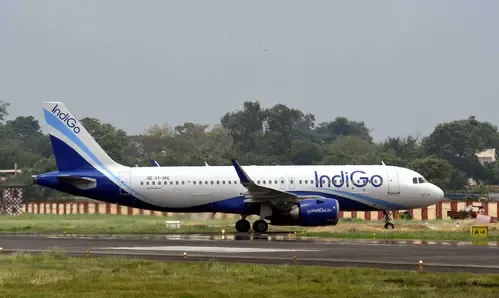Did an IndiGo aircraft's tail touch the runway at Mumbai Airport?

Synopsis
Key Takeaways
- IndiGo Airbus A321 experienced tail contact with the runway.
- Incident occurred during a low-altitude go-around in Mumbai.
- No injuries reported; aircraft landed safely afterward.
- IndiGo to perform necessary checks before resuming operations.
- DGCA issued a notice regarding pilot training compliance.
Mumbai, Aug 16 (NationPress) An IndiGo Airbus A321 aircraft's tail made contact with the runway during adverse weather conditions while initiating a low-altitude go-around procedure in Mumbai on Saturday, as reported by the airline.
In challenging weather scenarios, pilots of airlines often choose to execute a go-around rather than attempt a landing under unsafe circumstances.
According to an IndiGo spokesperson, "On August 16, 2025, the tail of an IndiGo Airbus A321 brushed the runway while performing a low-altitude go-around due to poor weather in Mumbai. The aircraft subsequently made another attempt and landed safely."
The airline confirmed it would adhere to all regulatory protocols prior to resuming operations.
Following standard procedures, the aircraft will undergo all essential inspections, repairs, and obtain necessary regulatory approvals before returning to service, the spokesperson added.
“At IndiGo, the safety of our passengers, crew, and aircraft remains our utmost priority. We are committed to minimizing any disruptions to our operations following this incident,” stated the IndiGo spokesperson.
The Directorate General of Civil Aviation (DGCA) issued a show-cause notice to IndiGo last week regarding the training of 1,700 pilots at three key airports with demanding runway conditions, which require specialized aircraft handling to ensure safe landings and takeoffs using "non-qualified simulators."
The notice indicated that IndiGo had utilized unqualified simulators to train flight commanders and first officers for operations at Category C (Critical) airfields.
Upon reviewing IndiGo's simulator training records, it was found that numerous Full Flight Simulators employed for testing, training, or assessing airfields such as Kozhikode, Leh, and Kathmandu were not certified or authorized for the specific airport models as mandated by Civil Aviation Rules (CAR), according to the DGCA.
The notice further stated that IndiGo violated CAR regulations by failing to ensure that training for Class III (critical) airports was conducted using appropriately qualified simulators.









